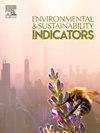Forecasting the potential habitat for the spectacled bear and the Páramo ecoregion for current conditions and climate change scenarios in 2050: A contribution to SDG 15 in Perú, Ecuador and Colombia
IF 5.4
Q1 ENVIRONMENTAL SCIENCES
引用次数: 0
Abstract
SDG 15, part of the UN's 2030 Agenda, focuses on "Life on Land". Target 15.5 aims to address habitat degradation, halt biodiversity decline, and protect species from extinction by 2020. Linked to the Red List Index (15.1.1) and its sub-indicator (15.5.1.2), we integrated a methodology to support endangered species and ecoregions in the Life on Land-NASA Project for Peru, Ecuador, and Colombia. This complements the Red List metric, harmonizing reporting systems and facilitating comprehensive SDG 15 reporting. These countries selected the Spectacled bear and the Páramo ecoregion as pilot species and ecoregion to establish a method for forecasting their habitat suitability for SDG 15 reporting (2019–2022). We used the SDM R package to model habitat suitability with 1,192 occurrence records and 1,000 pseudo-absences for the Spectacled bear, and 50,147 occurrence records and 10,000 pseudo-absences for the Páramo. The modeling incorporated 19 Bioclim variables, elevation, and Human Footprint for a baseline (1970–2000) and three RCPs for 2050. The habitat suitability modeling indicated a decline in the spectacled bear's habitat for two RCPs in the high occurrence category. The Páramo ecoregion showed a decrease in all RCPs in the high occurrence probability. Random Forest outperformed other models within the SDM. For the spectacled bear, altitude was crucial for current conditions, while bio6 (Min Temperature of Coldest Month) was significant for RCPs. Elevation was the most important variable for the Páramos in both current conditions and RCPs 2050.
在当前条件和2050年气候变化情景下预测眼镜熊和Páramo生态区域的潜在栖息地:为Perú、厄瓜多尔和哥伦比亚的可持续发展目标15做出贡献
可持续发展目标15是联合国2030年议程的一部分,重点关注“陆地上的生命”。具体目标15.5旨在到2020年解决栖息地退化问题,阻止生物多样性下降,保护物种免于灭绝。与红色名录指数(15.1.1)及其子指标(15.5.1.2)相联系,我们整合了一种方法来支持秘鲁、厄瓜多尔和哥伦比亚的陆地生命nasa项目中的濒危物种和生态区域。这是对红色清单指标的补充,有助于协调报告体系并促进全面的可持续发展目标15报告。这些国家选择眼镜熊和Páramo生态区作为试点物种和生态区,为可持续发展目标15(2019-2022)报告建立预测其栖息地适宜性的方法。我们使用SDM R软件包对眼镜熊的1192条发生记录和1000条伪缺席和Páramo的50147条发生记录和10000条伪缺席进行生境适宜性建模。该模型将19个生物气候变量、海拔和人类足迹作为基准(1970-2000年)和2050年的3个rcp。生境适宜性模型表明,高发生率的2个rcp的生境有所下降。在Páramo生态区,所有的rcp在高发生概率区域都有所下降。随机森林在SDM中的表现优于其他模型。对于眼镜熊来说,海拔高度对当前条件至关重要,而对于rcp来说,bio6(最冷月最低温度)至关重要。在当前条件和rcp 2050条件下,海拔是Páramos最重要的变量。
本文章由计算机程序翻译,如有差异,请以英文原文为准。
求助全文
约1分钟内获得全文
求助全文
来源期刊

Environmental and Sustainability Indicators
Environmental Science-Environmental Science (miscellaneous)
CiteScore
7.80
自引率
2.30%
发文量
49
审稿时长
57 days
 求助内容:
求助内容: 应助结果提醒方式:
应助结果提醒方式:


